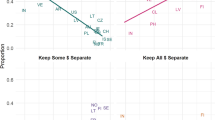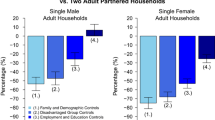Abstract
This paper studies the dynamics of financial responsibility division within mixed-gender couples. Analysis is based on individuals’ self-assessments of their own contribution to four household activities collected in the Survey of Consumer Payment Choice. A series of logistic regressions link reported roles from 3728 households to respondent gender and six household characteristics, representing aggregate and relative attributes with respect to age, education, and income. A second, longitudinally-based analysis relates reported contribution levels in subsequent survey years to changes in household income dynamics. For bill payments, the data are consistent with a bargaining model in which relative income rankings, more so than other household variables, relate to responsibility shares. For decisions about saving and investments and decisions on other financial matters, in addition to income rank, there is also some evidence that greater relative educational attainment coincides with greater responsibility shares. For household shopping, however, tendencies in household role assignment seem predominantly driven by gender considerations. Females across all household types consistently do more of the shopping, and females are much more likely to increase their contribution, even when they become the primary earner.








Similar content being viewed by others
Data Availability
The data analyzed are available at the Survey of Consumer Payment Choice website: https://www.atlantafed.org/banking-and-payments/consumer-payments.
References
AAPOR. (2016). Address-Based Sampling. http://www.aapor.org/Education-Resources/Reports/Address-based-Sampling.aspx
ALP. (2023). American life panel. https://mmicdata.rand.org/alp/
Archuleta, K. L. (2013). Couples, money, and expectations: Negotiating financial management roles to increase relationship satisfaction. Marriage and Family Review, 49(5), 391–411. https://doi.org/10.1080/01494929.2013.766296
Becker, G. S. (1965). A treatise on the allocation of time. Economic Journal, 75, 493–517.
Belloc, I., Molina, J. A., & Velilla, J. (2022). How does intrahousehold bargaining power impact labor supply? european cross-country evidence (2004-2019). GLO Discussion Paper, No. 1132. http://hdl.handle.net/10419/261323
Bennett, F. (2013). Researching within-household distribution: Overview, developments, debates, and methodological challenges. Journal of Marriage and Family, 75(3), 582–597. https://doi.org/10.1111/jomf.12020
Bertocchi, G., Brunetti, M., & Torricelli, C. (2014). Who holds the purse strings within the household? The determinants of intra-family decision making. Journal of Economic Behavior and Organization, 101, 65–86. https://doi.org/10.1016/j.jebo.2014.02.012
Bertrand, M., Kamenica, E., & Pan, J. (2015). Gender identity and relative income within households. Quarterly Journal of Economics, 130(2), 571–614. https://doi.org/10.1093/qje/qjv001
Bianchi, S. M., Milkie, M. A., Sayer, L. C., & Robinson, J. P. (2000). Is anyone doing the housework? Trends in the gender division of household labor. Social Forces, 79(1), 191–228. https://doi.org/10.1093/sf/79.1.191
Bittman, M., England, P., Folbre, N., Sayer, L., & Matheson, G. (2003). When does gender trump money? Bargaining and time in household work. American Journal of Sociology, 109(1), 186–214. https://doi.org/10.2307/3598347
Blumberg, R. L. (1991). Gender, Family, and Economy. Sage Publications.
Blumstein, P., & Schwartz, P. (1983). American Couples: Money, Work, Sex. William Morrow.
Booysen, F., & Guvuriro, S. (2021). Gender differences in intra-household financial deicions-making: An application of coarsened exact matching. Journal of Risk and Financial Management, 14, 469–479. https://doi.org/10.3390/jrfm14100469
Browning, M., Chiappori, P.-A., & Weiss, Y. (2007). Economics of the Family. Cambridge University Press.
Cantillon, S. (2013). Measuring differences in living standards within households. Journal of Marriage and Family, 75(3), 598–610. https://doi.org/10.1111/jomf.12023
Chau, T. W., Li, H., Liu, P. W., & Zhang, J. (2007). Testing the collective model of household labor supply: Evidence from china. China Economic Review, 18(4), 389–402. https://doi.org/10.1016/j.chieco.2006.12.002
Chiappori, P.-A., Fortin, B., & Lacroix, G. (2002). Marriage market, divorce legislation, and household labor supply. Journal of Political Economy, 110(1), 37–72. https://doi.org/10.1086/324385
Coltrane, S. (2000). Research on household labor: Modeling and measuring the social embeddedness of routine family work. Journal of Marriage and the Family, 62(4), 1208–1233. https://doi.org/10.1111/j.1741-3737.2000.01208.x
Dobbelsteen, S., & Kooreman, P. (1997). Financial management, bargaining, and efficiency within the household: An empirical analysis. De Economist, 145(3), 345–366. https://doi.org/10.1023/A:1003008229588
Elder, H. W., & Rudolph, P. M. (2003). Who makes the financial decisions in the households of older Americans? Financial Services Review, 12, 293–308.
Fowler, F. J. (1995). Improving Survey Questions: Design and Evaluation. Sage Publications.
Friedberg, L., & Webb, A. (2006). Determinants and consequences of bargaining power in households. NBER Working Paper 12367. https://doi.org/10.3386/w12367
Gelman, A., Carlin, J. B., Stern, H. S., & Rubin, D. B. (2004). Bayesian Data Analysis (2nd ed.). Chapman & Hall/CRC.
Gelman, A., & Hill, J. (2009). Data Analysis Using Regression and Multilevel/Hierarchical Models (2nd ed.). Cambridge University Press.
Gobbi, P. E., Parys, J., & Schwerhoff, G. (2018). Intra-household allocation of parental leave. Canadian Journal of Economics, 51(1), 236–274. https://doi.org/10.1111/caje.12322
Gupta, S. (2007). Autonomy, dependence, or display? The relationship between married women’s earnings and housework. Journal of Marriage and Family, 69(2), 399–417. https://doi.org/10.1111/j.1741-3737.2007.00373.x
Henau, J. D., & Himmelweit, S. (2013). Unpacking within-household gender differences in partners’ subjective benefits from household income. Journal of Marriage and Family, 75(3), 611–624. https://doi.org/10.1111/jomf.12027
Himmelweit, S., Santos, C., Sevilla, A., & Sofer, C. (2013). Sharing of resources within the family and the economics of household decision making. Journal of Marriage and Family, 75(3), 629–639. https://doi.org/10.1111/jomf.12032
Hitczenko, M. (2021). Sample bias related to household role. Journal of Survey Statistics and Methodology, 9(4), 891–918. https://doi.org/10.1093/jssam/smaa001
Huston, T. L., & Burgess, R. L. (1979). Social exchange in developing relationships. In T. L. Huston & R. L. Burgess (Eds.), Social Exchange in Developing Relationships (pp. 3–28). Academic Press.
Johnston, D. W., Kassenboehmer, S. C., & Shields, M. A. (2016). Financial decision-making in the household: Exploring the importance of survey respondent, health, cognitive ability, and personality. Journal of Economic Behavior and Organization, 132(Part A), 42–61. https://doi.org/10.1016/j.jebo.2016.09.014
Kamo, Y. (2000). He said, she said: Assessing discrepancies in husbands’ and wives’ reports on the division of household labor. Social Science Research, 29(4), 459–476. https://doi.org/10.1006/ssre.2000.0674
Kim, J., Gutter, M. S., & Spangler, T. (2017). Review of family financial decision making: Suggestions for future research and implications for financial education. Journal of Financial Counseling and Planning, 28(2), 253–267. https://doi.org/10.1891/1052-3073.28.2.253
Kirchler, E., Rodler, C., Holzl, E., & Meier, K. (2001). Conflict and Decision Making in Close Relationships: Love, Money and Daily Routines. Psychology Press.
Lam, C. B., McHale, S. M., & Crouter, A. C. (2012). The division of household labor: Longitudinal changes and within-couple variation. Journal of Marriage and Family, 74(5), 944–952. https://doi.org/10.1111/j.1741-3737.2012.01007.x
Luhrmann, M., & Maurer, J. (2007). Who wears the trousers? A semiparametric analysis of decision power in couples. Cemmap Working Paper CWP25/07. https://doi.org/10.1920/wp.cem.2007.2507
Lundeberg, M. A., Fox, P. W., & Punccohar, J. (1994). Highly confident but wrong: Gender differences and similarities in confidence judgments. Journal of Educational Psychology, 86(1), 114–121. https://doi.org/10.1037/0022-0663.86.1.114
Mannino, C. A., & Deutsch, F. M. (2007). Changing the division of household labor: A negotiated process between partners. Sex Roles, 56(5), 309–324. https://doi.org/10.1007/s11199-006-9181-1
McCullagh, P., & Nelder, J. A. (1989). Generalized Linear Models (2nd ed.). Chapman and Hall.
McElroy, M. B., & Horney, M. J. (1981). Nash-bargained household decisions: Toward a generalization of the theory of demand. International Economic Review, 22(2), 333–349. https://doi.org/10.2307/2526280
Mizan, A. N. (1994). Family power studies: Some major methodological issues. International Journal of Sociology of the Family, 24(2), 841–854.
Moore, D. A., & Healy, P. J. (2008). The trouble with overconfidence. Psychological Review, 115(2), 502–517. https://doi.org/10.1037/0033-295X.115.2.502
Oreffice, S. (2011). Sexual orientation and household decision making: Same-sex couples’ balance of power and labor supply choices. Labour Economics, 18(2), 145–158. https://doi.org/10.1016/j.labeco.2010.09.003
Pahl, J. (1983). The allocation of money and structuring of inequality within marriage. Sociological Review, 13(2), 237–262. https://doi.org/10.1111/j.1467-954X.1983.tb00389.x
Pahl, J. (1989). Money and Marriage. Macmillan.
Parkman, A. M. (2004). Bargaining over housework. American Journal of Economics and Sociology, 63(4), 765–794. https://doi.org/10.1111/j.1536-7150.2004.00316.x
Safilios-Rothschild, C. (1976). A macro- and micro-examination of family power and love: An exchange model. Journal of Marriage and Family, 38(2), 355–362. https://doi.org/10.2307/350394
Schneider, D. (2012). Gender deviance and household work: The role of occupation. American Journal of Sociology, 117(4), 1029–1072. https://doi.org/10.1086/662649
SCPC. (2008-2019). Survey of consumer payment choice. https://www.frbatlanta.org/banking-and-payments/consumer-payments/survey-of-consumer-payment-choice
South, S. J., & Spitze, G. (1994). Housework in marital and nonmarital households. American Sociological Review, 59(3), 327–347. https://doi.org/10.2307/2095937
Thebaud, S., Kornrich, S., & Ruppanner, L. (2019). Good housekeeping, great expectations: Gender and housework norms. Sociological Methods and Research, 50(3), 1186–1214. https://doi.org/10.1177/0049124119852395
UAS. (2023). Understanding America study. https://cesr.usc.edu/
Vogler, C., Lyonette, C., & Wiggins, R. D. (2008). Money, power and spending decisions in intimate relationships. The Sociological Review, 56(1), 117–143. https://doi.org/10.1111/j.1467-954X.2008.00779.x
Funding
This research did not receive any specific grant from funding agencies in the public, commercial, or not-for-profit sectors.
Author information
Authors and Affiliations
Corresponding author
Ethics declarations
Conflict of interest
The author receives a salary as an employee of the Federal Reserve of Atlanta.
Ethical Approval
All research activities and protocol were approved by the University of Southern California Internal Review Board.
Informed Consent
All panelists in the Understanding America Study and participants in the Survey of Consumer Payment Choice provided informed consent for data collection.
Consent for Publication
The author hereby provides consent for publication.
Additional information
Publisher's Note
Springer Nature remains neutral with regard to jurisdictional claims in published maps and institutional affiliations.
Appendix A
Appendix A
In general, I adopt weakly informative priors, meant to guide estimates away from unrealistic values rather than serve as an influential source of information. Characteristic level effects that achieve the desired monotonicity condition in (5) are parameterized as follows:
where \(\textrm{Normal}^+(0,1)\) refers to a normal distribution with standard deviation 1 restricted to non-negative values. The parameter priors are chosen with regard to the size of the jump from one characteristic level to another, so that such a change, given by \(\tau _i\times \gamma\), is less than one-half about 78% of the time and less than one about 94% of the time, nontrivial changes on the logistic scale. Estimation with a more conservative prior on jump size, \(\tau _c^i\sim \textrm{Normal}^+(0,0.5)\) was also used and yielded virtually identical 90% posterior intervals.
Priors for the cubic effects relating to changes in income dynamics are given \(\lambda _0 \sim \textrm{Normal}(0,1)\) and \(\lambda _1,\lambda _2,\lambda _3 \sim \textrm{Normal}(0,.5)\).
Rights and permissions
Springer Nature or its licensor (e.g. a society or other partner) holds exclusive rights to this article under a publishing agreement with the author(s) or other rightsholder(s); author self-archiving of the accepted manuscript version of this article is solely governed by the terms of such publishing agreement and applicable law.
About this article
Cite this article
Hitczenko, M. Division of Financial Responsibility within Mixed-Gender Couples. J Fam Econ Iss (2024). https://doi.org/10.1007/s10834-023-09944-6
Accepted:
Published:
DOI: https://doi.org/10.1007/s10834-023-09944-6




